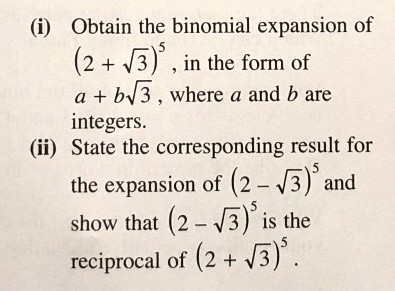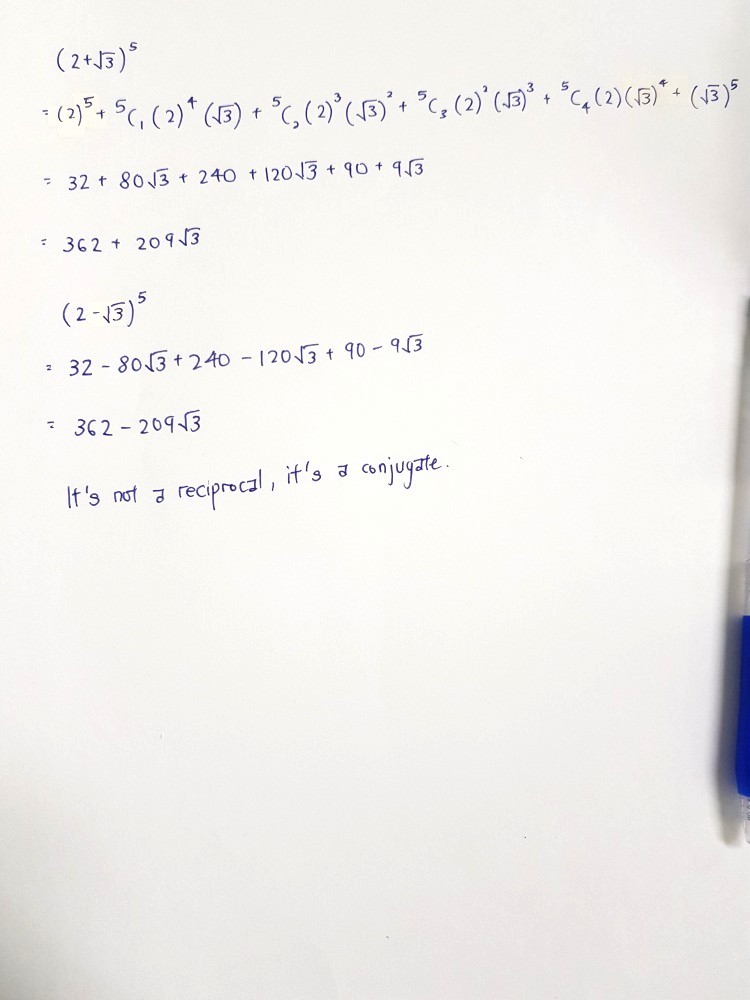Ask Singapore Homework?
Upload a photo of a Singapore homework and someone will email you the solution for free.

See 1 Answer
done
{{ upvoteCount }} Upvotes
clear
{{ downvoteCount * -1 }} Downvotes
Might want to revise binomial theorem a bit, this is a "copy formula and press calculator" question.
I don't think it's called a reciprocal though, reciprocal just means "1 divided by".
I don't think it's called a reciprocal though, reciprocal just means "1 divided by".
Date Posted:
4 years ago
No, it is really a reciprocal.
If two numbers are reciprocals of one another, they multiply to 1.
We must multiply the two conjugates and show that they are equal to 1.
362 x 362 = 131044.
209 x 209 x 3 = 131043.
Their difference is 1.
If two numbers are reciprocals of one another, they multiply to 1.
We must multiply the two conjugates and show that they are equal to 1.
362 x 362 = 131044.
209 x 209 x 3 = 131043.
Their difference is 1.
In fact, we do not even need to use the power 5 version to show that the terms are indeed reciprocal.
2 + sq 3 is the reciprocal of 2 - sq 3 simply because they multiply to 1.
If not for the fact that the question wants the candidate to use the power 5 version, I would rather use the power 1 version.
2 + sq 3 is the reciprocal of 2 - sq 3 simply because they multiply to 1.
If not for the fact that the question wants the candidate to use the power 5 version, I would rather use the power 1 version.
Oh wow, they actually multiply to 1? I dun goof'd for not checking haha. Good catch. Now wondering if I should delete my answer.
No need to delete the answer since you have put in the hard work and time to write the answer which is correct already; the reader should be able to decipher what I have supplemented from this comments section.
① Rationalising denominator method :
1/(2 + √3)^5
= 1/(362 + 209√3)
= 1/(362 + 209√3) x (362 - 209√3)/(362 - 209√3)
= (362 - 209√3)/(362² - (209√3)²)
= (362 - 209√3)/(131044 - 131043)
= (362 - 209√3)/1
= 362 - 209√3
= (2 - √3)^5 (shown)
OR
1/(2 + √3)^5
= (1/(2 + √3))^5
= ( 1/(2 + √3) x (2 - √3)/(2 - √3) )^5
= ( (2 - √3)/(2² - (√3)²) )^5
= ( (2 - √3)/(4 - 3) )^5
= ( (2 - √3)/1)^5
= (2 - √3)^5
(Shown)
② Direct multiplication method :
(2 + √3)^5 x (2 - √3)^5
= (362 - 209√3)(362 + 209√3)
= 362² - (209√3)²
= 131044 - 131043
= 1
Since (2 + √3)^5 x (2 - √3)^5 = 1,
then 1/(2 + √3)^5 = (2 - √3)^5
(Shown)
OR
(2 + √3)(2 - √3)
= 2² - (√3)²
= 4 - 3
= 1
Since (2 + √3)(2 - √3) = 1,
1/(2 + √3) = (2 - √3)
( 1/(2 + √3) )^5 = (2 - √3)^5
1/(2 + √3)^5 (1^5 is just 1)
= (2 - √3)^5
(Shown)
1/(2 + √3)^5
= 1/(362 + 209√3)
= 1/(362 + 209√3) x (362 - 209√3)/(362 - 209√3)
= (362 - 209√3)/(362² - (209√3)²)
= (362 - 209√3)/(131044 - 131043)
= (362 - 209√3)/1
= 362 - 209√3
= (2 - √3)^5 (shown)
OR
1/(2 + √3)^5
= (1/(2 + √3))^5
= ( 1/(2 + √3) x (2 - √3)/(2 - √3) )^5
= ( (2 - √3)/(2² - (√3)²) )^5
= ( (2 - √3)/(4 - 3) )^5
= ( (2 - √3)/1)^5
= (2 - √3)^5
(Shown)
② Direct multiplication method :
(2 + √3)^5 x (2 - √3)^5
= (362 - 209√3)(362 + 209√3)
= 362² - (209√3)²
= 131044 - 131043
= 1
Since (2 + √3)^5 x (2 - √3)^5 = 1,
then 1/(2 + √3)^5 = (2 - √3)^5
(Shown)
OR
(2 + √3)(2 - √3)
= 2² - (√3)²
= 4 - 3
= 1
Since (2 + √3)(2 - √3) = 1,
1/(2 + √3) = (2 - √3)
( 1/(2 + √3) )^5 = (2 - √3)^5
1/(2 + √3)^5 (1^5 is just 1)
= (2 - √3)^5
(Shown)






